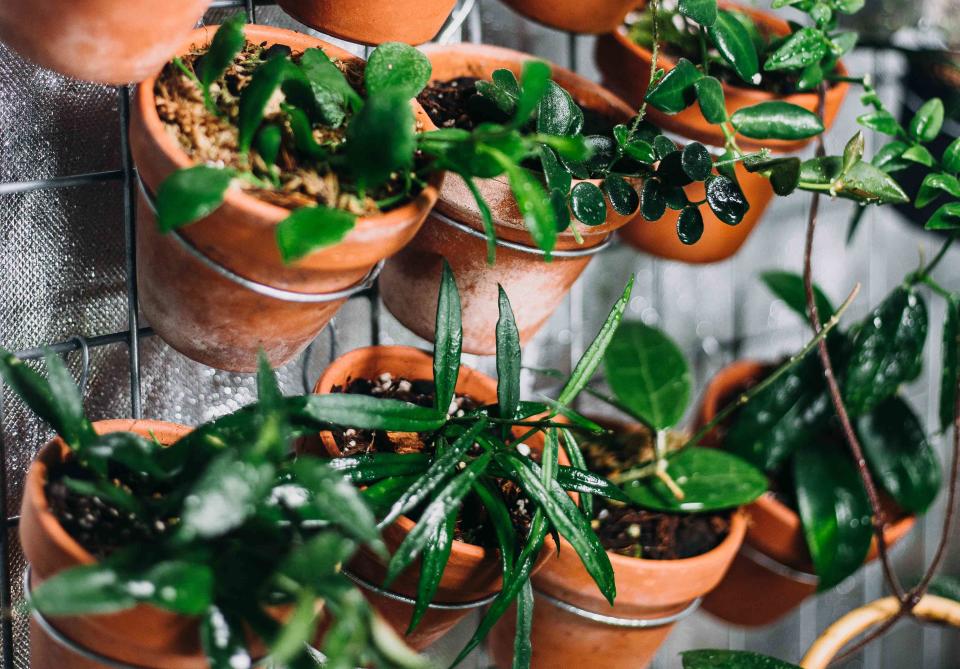Vertical Gardening Ideas To Try This Season
Fences and walls and trees, oh my!

Getty Images
Just like home decor and fashion have their own trends, so does gardening. The latest? Vertical gardens. Whether you’re short on ground space or just want to do something unique, it’s a fun way to turn your beloved plants into a statement. Plus, it has a ton of different applications both indoors and outdoors. Read on to learn exactly what vertical gardening is, how to maintain it, what to plant, and much more.
What Is Vertical Gardening?
At its most basic, it’s exactly what it sounds like: using vertical space to grow plants. “Many people think vertical gardening is just plant walls and hydroponic structures,” shares Mike Mosel, General Manager of online plant company Yarden. “Those are great systems, but it’s more than that—it’s about incorporating the right plants and structure to utilize the three-dimensional growing space you have to work with.” And it’s not just a trend for the outdoors. “Plant walls are a great way to bring your garden indoors, improve indoor air quality, and add a beautiful design element into your home,” Mosel finishes.
What To Know Before You Grow
The most important thing to keep in mind: “Waterproofing is vital, whether you’re hanging it indoors or outdoors, so the surfaces on which they hang aren’t damaged,” explains Debbie Neese, Horticulture Expert at Lively Root. Another big consideration is irrigation. “A drainage system must be in place, so the roots are not waterlogged and drown,” she continues. After that, Neese shares the basics that come into play: placing plants that are made for the amount of light available and using clean, fresh, well-draining potting mix specific to whatever you’re planting.
Maintaining a Vertical Garden
Maintenance for vertical gardens is fairly similar to any other garden. “Always water at the base of the plant instead of wetting the leaves. This method of watering can help prevent fungus and mildew growth,” advises Neese. How much you water is dependent on root depth, temperature, light, and airflow. You need to watch for diseases as well. “Do grooming once a week by looking under the leaves and steams for pests that can be hiding out,” she says. “Also, prune the stems when the plants get leggy to keep the plant pushy.” Compared to a typical garden, this care is more minimal. “Keeping plants off the ground can benefit and simplify maintenance since it protects them from garden pests. Weeds are also reduced since they're not getting watered via the ground,” she explains.
Vertical Garden Structures
There’s a wide range of ways to achieve a vertical garden, some of which are more obvious: fruit trees, a trellis, and hanging plants. You can also employ the use of your fence or railing, giving them new life. “If you’re the DIY type, you can build your own vertical garden box. If building on your own, you’ll want to find a naturally rot-resistant wood like cedar,” Mosel says. “Another option is to buy an all-in-one kit online. There are some really innovative brands making vertical gardening systems and plant wall kits.” Basically, as long as it’s vertical, it’s fair game.
Vertical Garden Plants
“When it comes to choosing plants for your vertical garden, it all depends on your goals and the amount of space you have for each plant,” Mosel explains. For plant walls and stand-alone systems, he recommends starting small. “For indoor plant walls, peperomia, pothos, ferns, and small philodendrons are great choices,” he continues. “For outdoor vegetable vertical gardens, leafy greens like spring mix, romaine, or butter lettuce works great.” Herbs like mint, parsley, or basil, as well as edible flowers like nasturtium, do as well. Plus, as Neese points out, “herbs and spices used for cooking can be beneficial to provide aromatic, culinary, and medicinal benefits.”
If you have a trellis, climbing vines are just the beginning of your possibilities. “A potted blackberry or passionfruit plant will create a wall of vines and produce delicious fruit. If you want veggies, cucumbers are a great option for vertical gardening with a trellis,” says Mosel. He also recommends incorporating fruit trees. “It doesn’t get much better than growing your own citrus and picking it fresh from the tree right on your patio or balcony.”
For more Southern Living news, make sure to sign up for our newsletter!
Read the original article on Southern Living.

